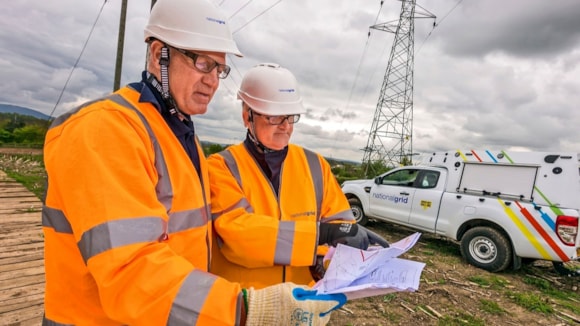
National Grid starts work on connection for UK’s biggest EV battery factory
- Multi-million pound electrical engineering project is underway to connect biggest battery factory in the country to the grid
- Factory will contribute almost half of the projected battery manufacturing capacity required for the UK and create thousands of new high-skilled green tech jobs
- Connection project is part of £30 billion investment from National Grid to upgrade the grid to meet future demand
A major National Grid engineering project is underway to meet the power needs of the UK’s biggest electric vehicle battery-making facility that’s being built in Somerset.
The multi-million-pound scheme is vital for the creation of a 40GWh factory at the 620-acre Gravity Smart Campus near Bridgwater that will create 4,000 highly skilled green tech jobs.
The production facility – run by Tata Group’s global battery business Agratas – is due to open in 2026 and aims to supply almost half of the batteries needed by the UK’s automotive industry by the early 2030s.
Providing the power to run the multi-billion pound facility is now the focus of a significant new electricity infrastructure project.
National Grid Electricity Distribution (NGED) is building two interim 33kV connections which will power the Agratas site until a high voltage 400kV substation, built by National Grid Electricity Transmission (NGET), is complete.
Energy Minister Michael Shanks said: “This is a major milestone in a journey to bring 4,000 highly skilled clean energy jobs to Bridgwater, as a former munitions works transforms into a leading electric vehicle battery factory. In Somerset, and across the country, the clean energy transition is revitalising our industrial heartlands and bringing opportunity, growth and jobs to our communities.
“Our Clean Power Action Plan sets out how we will deliver a new era of clean electricity, with the most ambitious reforms to the country’s energy system in a generation. This includes re-ordering the grid connection queue so we can free up capacity and accelerate connections for vital projects like this.”
Work is underway on the first NGED connection, which will see a new bulk supply point at Dunwear with two 132/33kV transformers along with circuit breaker bays close to an existing grid supply point nearby. The grid transformers will feed a new 33kV switchboard from which the Gravity connection and other customers will be supplied.
The second connection will see five miles of cables laid from the Bridgwater bulk supply point substation to an Independent Connection Provider switchroom at Gravity. This work is underway and will take advantage of a route laid by NGED several years ago in anticipation of the site’s future needs.
NGED President Cordi O’Hara said: “The Agratas battery factory at Gravity is set to bring thousands of skilled jobs and provide a boost to the regional economy, as well as pushing forward the electrification of transport across the country. This is a clear example of networks acting as a catalyst for growth and shows the benefits that upgraded networks can bring. We are committed to investing significantly in our network so it can deliver energy where it is needed for customers.”
Following a request from Agratas to connect the factory to the UK high voltage transmission network, NGET plans to build a new 400kV transmission substation at Woolavington. NGET will work closely with local residents and stakeholders as that work progresses throughout 2025.
John Twomey, Director of Customer Connections at NGET, said: “Connections like this are a great example of our role unlocking economic growth and transport decarbonisation for the UK, as well as bringing jobs to this region. I’m delighted to see National Grid’s connection project kick off with these distribution network upgrades. Our new transmission substation is now at an early planning stage and we look forward to sharing more with the community as it develops further.”
Jefferson Weber, Head of UK Construction for Agratas, said: “The electrical connection being developed by National Grid is a critical infrastructure project that will supply the essential power needed to operate our new facility. This connection is fundamental to ensuring the reliable energy supply required to support what will be the UK’s largest battery manufacturing facility. National Grid’s expertise in delivering this key project is vital to the success of our site and will help us achieve our ambitious goals.”
Site preparation at the Agratas Somerset facility is progressing steadily, with the project reaching a major milestone: the completion of all piling operations. More than 16,800 piles have been successfully installed. Key infrastructure is also in place, including a dedicated construction access road and fully operational site cabins. In addition, groundwork and pile cap activities are well underway, marking continued progress across the site.
The battery factory is the latest major grid connection National Grid is undertaking across its transmission and distribution networks.
Recent transmission connections include the UK’s largest transmission connected battery at Drax in Yorkshire, part of the 3GW of generation and several hundred megawatts of demand capacity added in the last year.
On its distribution network, last year there were 42% more demand and 28% more generation connection requests than the year before. There have also been twice as many EV connections in the past two years than all previous years combined.
The connection of new demand sources, such as battery factories, is expected to contribute to an increase in Britain’s overall annual electricity demand from industry of around 30% between now and 2035.


